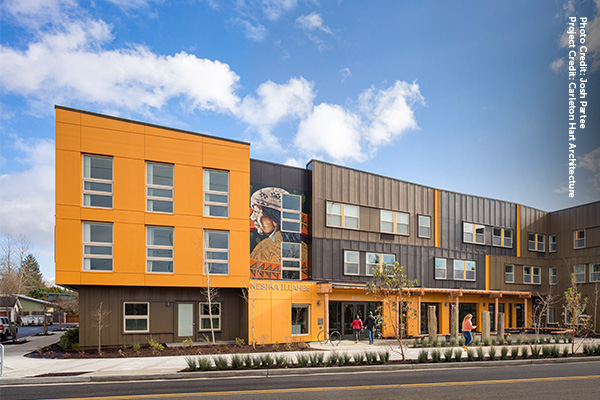SLB Insights
Softwood lumber is a key piece of the housing solution
Softwood lumber is a key piece of the housing solution
To make housing more affordable across the United States, a variety of housing types are needed—especially multifamily. Here’s how the SLB is working to secure the industry’s position in medium- and high-density residential construction.
Single-family residential construction and renovations have long been the primary market for the lumber industry. But single-family construction alone will not meet the demand for housing in the United States—nor will it be a driver for incremental growth in lumber demand.
A shortage of housing is causing major affordability issues across the country. The Joint Center for Housing Studies at Harvard University’s 2024 America’s Rental Housing report found that a record-high 22.4 million renter households spent more than 30 percent of their income on rent and utilities, more than at any other time in history, as rent increases have outpaced income gains for decades.

With millennials aging into their prime ownership years, growth in rental demand is coming from young Gen Z renters, the JCHS report found, so the affordability issues are hitting that generation the hardest. With little savings built up to purchase a home and rent costs being driven higher by inflation and limited housing availability, more than one-third of Gen Z and millennials are “doom spending”—spending money despite concerns about the economy to cope with stress.
Making housing more affordable with lumber
Small college towns are seeing some of the fiercest competitions for rentals, with demand spurred by Gen Z students and newcomers escaping high-priced cities. Fayetteville, Arkansas—RentCafe’s most competitive small rental market—and nearby Springdale have been hit particularly hard by the housing shortage. Major employers including Walmart and Tyson’s Foods, as well as access to recreation and nature in the Ozark Mountains, have helped make the Northwest Arkansas region the 13th fastest growing area in the United States. But the housing market has failed to keep up with that growth. Springdale’s multifamily vacancy rate in the first half of 2023 was a mere 2.5%.
Real estate developer Blue Crane and Modly, an industrialized construction consultancy, saw an opportunity to meet the need for more rental housing with a mix of multifamily unit types at market rate. Blue Crane’s Via Emma development in Springdale and the Northwest Arkansas Industrialized Construction Program were winners of the 2023 Mass Timber Competition, a competition executed and funded by the Softwood Lumber Board and USDA Forest Service to showcase the expanded use of mass timber in the United States and inspire broader adoption.

Via Emma is an affordable workforce housing project in northwest Arkansas with two buildings constructed using conventional wood framing and two built with a hybrid mix of light-frame walls and a standardized kit of CLT parts and bathroom modules, exploring further possibilities for offsite construction with wood.
Via Emma was recognized in the competition because of the way it grapples with the affordable housing shortage by using mass timber alongside wood-frame and prefabricated construction. “The Mass Timber Competition award gave us a venue to develop our thinking even more,” says Fouad Khalil, principal of Modly. “It allowed us to set our horizon further on things we can do next.”
The affordability challenge and opportunity
Solving the housing shortage will take more ideas like Via Emma and other projects that, without direct assistance from industry groups like the SLB, would struggle to break ground or have their project team learnings shared with the rest of the design community.
Beyond the Mass Timber Competition, the SLB’s funded programs—WoodWorks, Think Wood, the American Wood Council (AWC), and SLB Education—are working cooperatively to reduce barriers to this construction type and raise awareness about the potential for wood construction to make mid-size, 2–8 story multifamily projects economically and environmentally viable.

Nesika Illahee, a three-story light-frame wood affordable housing project with 59 residential units in Portland, Oregon, was featured in a Think Wood profile highlighting architecture firm Carleton Hart’s use of wood for its flexibility and biophilic design benefits.
WoodWorks works directly with design and construction teams to facilitate a shift toward wood with free one-on-one project assistance, and light-frame projects comprise 66% of the program’s reported projects. Multifamily accounted for 73% of those light-frame projects in 2023 and 80% of supported light-frame projects historically.
The AWC has long worked to educate local governments and building officials about the affordability benefits and safety of wood systems. For example, in 2023, after the AWC spent years building coalitions with sustainable building and affordable housing advocates in California, a Los Angeles ban on Type IV and V wood construction was allowed to expire despite the efforts of the wood industry’s competitors.
Think Wood, the SLB-funded marketing and communications program that builds interest and intent to specify wood among architects, engineers, and developers, has produced a variety of content and continuing-education webinars focusing on the use of wood to make housing more affordable, including Growing Good Homes, a course that looks at looks at how light-frame construction and mass timber can help address the urgent timeline and budget of the housing problem. And the SLB-sponsored Timber in the City student design competition with the Association of Collegiate Schools of Architecture focuses on overbuilds, or vertical extensions, challenging architecture students to imagine denser urban living that is attractive, cost-efficient, and sustainable with wood construction.

The Detroit Eco Homes, a light-frame urban infill project focused on minimizing carbon footprint, was featured in the Think Wood-sponsored Growing Good Homes course.
Looking beyond single-family
Although current economic conditions have created a slowdown in new development, strong underlying fundamentals for rental housing demand mean the years ahead will likely see plenty of new investment in medium- and high-density housing. Through marketing and education, direct project support, and involvement in codes and standards development, the SLB’s investments are targeted to ensure as many of those new multifamily buildings as possible are built with wood construction.

